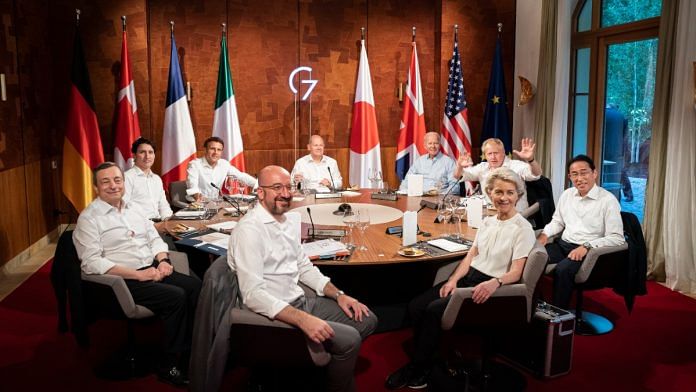New Delhi: US President Joe Biden, along with the heads of other G7 member states, formally launched a $600-billion global infrastructure investment partnership Sunday aimed at helping developing countries like India.
The Partnership for Global Infrastructure and Investment (PGII) was first unveiled by the G7 leadership last June as a plan to aid lower and middle-income countries in building better infrastructure.
Since it was first announced, the PGII has been viewed as a counter to China’s Belt and Road Initiative (BRI), which critics have termed a ‘debt trap’ not just for its allies but for Beijing itself.
Moreover, the PGII could benefit developing countries, and particularly India, by offering finance for decarbonisation efforts. Indian entrepreneurs and companies working to increase food security and improve the rural economy also stand to benefit from this global infrastructure investment partnership.
Announcing the official launch of the PGII, Biden said at the G7 Leaders’ Summit in Germany Sunday: “We collectively have dozens of projects already underway around the globe”.
According to Biden, the PGII’s objective is to help developing countries make improvements in four core areas: healthcare, digital connectivity, gender equality and equity, and climate and energy security.
Addressing the G7 Summit 2022, which is taking place at Schloss Elmau in Germany from 26 to 28 June, Biden said the US aims to mobilise $200 billion over the next five years to fund the PGII. The European Union (EU), too, had in December last year declared its aim to mobilise €300 billion in investments for the PGII by 2027.
Also Read: BRICS supports Russia-Ukraine talks at 14th Summit, Putin says ‘joint efforts’ answer to conflict
Areas of focus for PGII
With an eye on preventing and managing future pandemics, G7 member states plan to invest in industrial-scale vaccine manufacturing facilities in the developing world as part of the healthcare plank of the PGII.
In the context of digital connectivity, the PGII intends to secure digital network equipment for Africa, Asia and Latin America. To that effect, the partnership envisions a global subsea communications cable that will stretch from Southeast Asia, through the Middle East and the Horn of Africa, to Europe.
“We need to strengthen the use of trusted technologies so that our online information cannot be used by autocrats to consolidate their power or repress their people,” Biden said in his address at the G7 Leaders’ Summit Sunday.
In the area of gender equality and equity, the partnership proposes to make childcare more accessible in the developing world; the US has already committed $50 million to the World Bank’s global Childcare Incentive Fund by 2027.
The G7, as part of the PGII’s climate and energy security plank, further aims to help developing economies move away from coal. With the twin objectives of increasing regional energy trade by 5 per cent and deploying more clean energy technologies, the US plans to invest $40 million in South Asia alone.
India, Indonesia, Senegal and Vietnam, in particular, could be offered finance that can be routed towards decarbonisation efforts.
The International Development Finance Corporation (DFC) — a US government body — is also willing to invest up to $30 million in India to expand food security and improve agricultural systems that are climate-friendly.
At the summit, Biden said investments under the PGII would drive job creation in developing countries while also boosting the economies of the G7 countries. Projects built under the PGII will adhere to transparency and protections for labour and the environment, he said.
The US President added that the PGII could help reduce the need for US foreign aid in the future.
Biden, however, underlined that the investments are not intended to be “aid or charity”.
“I want to be clear: this isn’t aid or charity; it’s an investment that will deliver returns for everyone, including the American people and the people of all our nations. It’ll boost all of our economies, and it’s a chance for us to share our positive vision for the future and let communities around the world see themselves — and see for themselves the concrete benefits of partnering with democracies,” he said.
(Edited by Amrtansh Arora)
Also Read: Not a record to showcase: No US ambassador to India for 18 months & counting, longest ever



